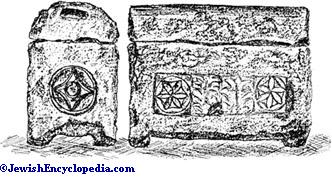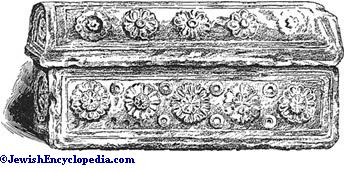Coffin
 From Jewish Encyclopedia (1906)
From Jewish Encyclopedia (1906) Coffin:
The custom of using coffins is probably borrowed from the Egyptians. It is recorded of Joseph that he was "put in a coffin in Egypt" (Gen. 1. 26). Tradition says it was of metal (Soṭah 13a). Both the Ark of the Covenant and the coffin are called, in Hebrew, "aron." The Talmud says that the "aron" (coffin) of Joseph was carried side by side with the "aron" (Ark) containing the Tables of the Law, so as to express the idea that "the one in this observed what is written upon the other" (Soṭah 13a et seq. ).
From the verse "Adam and his wife hid themselves. . . amongst [literally, "within"] the trees of the garden" is derived the custom of burial in a wooden coffin (Gen. R. xix.).
Talmudic Practise.Rabbi Judah ha-Nasi, in his will, ordered that a hole be made in the bottom of his coffin (Yer. Kil. vi.). Rabbi Jose b. Ḳisma, in his will, requested his disciples to bury his coffin deep in the ground, for fear of desecration, as he said there was not a coffin in Palestine which was not used as a feeding-trough for Persian horses (Sanh. 98a et seg. ). To prevent such abuse, the Jewish law prohibited any one from deriving plunder from a coffin or burial-clothes. A coffin must not be used for secular purposes. A coffin out of use, if of stone or earthenware, must be broken up; if of wood, it must be burned (Shulḥan 'Aruk, Yorch De'ah, 363, 5).
It appears, however, that the coffin was originally used for the purpose of transporting a corpse to a distant place of burial; and whenever the cortège passed, the mourning regulations were observed by the multitude (M. Ḳ. 25a). Bar Ḳarya and R. Lazar (=Eleazar b. Pedath), both Palestinian rabbis, had noticed the approach of funeral parties, from the direction of Babylon, bearing corpses in coffins for burial in the Holy Land. Bar Ḳarya asked, "What have they gained [by living away from, and being buried in, Palestine]?" and quoted from Jeremiah (ii. 7), "Ye entered, ye defiled my land and made mine heritage an abomination." "But," answered R. Lazar, "as soon as a clod of earth of the Holy Land is put on the coffin, there is applicable the passage" Deut. xxxii. 43:
 [= "His land will atone for His people]" (Yer. Kil. end; Ket. 35b; compare Bacher, "Ag. Pal. Amor." ii. 3).
[= "His land will atone for His people]" (Yer. Kil. end; Ket. 35b; compare Bacher, "Ag. Pal. Amor." ii. 3).
It was considered an honor for the deceased to be carried from the death-chamber on a litter ("miṭṭah") to the place of burial, and a greater honor, usually reserved for scholars, to be borne on the death-bed itself. In the case of R. Hunah it was necessary to enlarge the exit from the house to make room for the passage of his bed, his removal to a smaller bed not being permitted (M. Ḳ. 25a). Maimonides says that the body should be buried in a wooden coffin ("Yad," Ebel, vi. 4). On the other hand, Naḥmanides, in order that the words of the passage "Thou art dust, and unto dust shalt thou return" may be literally fulfilled, declares that according to the Talmud the coffin is for the skeleton after the flesh is consumed, and that the bottom of the coffin should be removed, as in the case of Rabbi (quoted by Caro in Bet Joseph to Ṭur Yorch De'ah, 362). In some countries it is customary to bury the dead in hammocks, and, after the flesh is consumed, to deposit the bones in a coffin (Shulḥan 'Aruk, ib. 363, 4). In other countries the dead are buried on simple boards, or placed directly in the ground ( see Burial ), a distinction being made only in case the dead is an Aaronite or of noble parentage. In modern times the use of coffins at every burial is insisted on.


Isaac Lampronti, in his Paḥad Yiẓḥaḳ (letter "Mem," p. 229), tells of a decision of 1678, in the case of Bizancia, the wife of Judah Ḥayyim of Corfu, who had requested her granddaughter, Semiralda, to place her (Bizancia's) head-dress in her coffin. Semiralda had, however, forgotten to do so; and a cabalist rabbi permitted the opening of the coffin in order to relieve her distress. The opening of the coffin was accompanied by prayers and ceremonial apologies to the dead for being disturbed. The almost universal former custom of putting the dead in a plain, unpainted wooden coffin covered with black cloth has been abandoned in modern times; and distinction is made, much against Jewish tradition, between rich persons and poor by more or less decorated coffins. Sometimes the bottom of the coffin is removed in order to bring the body into contact with the earth, for reasons stated above. In Jerusalem it is customary to carry the body on a litter to Mount Olivet, building in the grave a coffin of uncemented stoneslabs, with sides and a top, but with no bottom, and covering the enclosúre with earth ( see Burial ).
- Lampronti, Paḥad Yiẓḥaḳ.
Categories: [Jewish encyclopedia 1906]
↧ Download as ZWI file | Last modified: 09/04/2022 18:28:22 | 13 views
☰ Source: https://www.jewishencyclopedia.com/articles/4453-coffin.html | License: Public domain
 ZWI signed:
ZWI signed: KSF
KSF